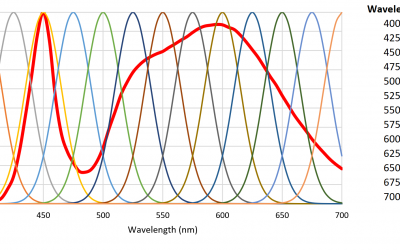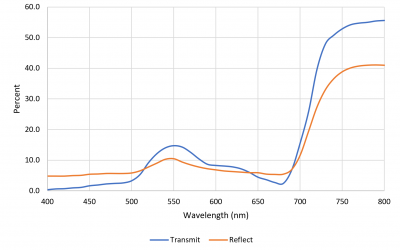The phrase déjà vu translates from French as “already seen,” which nicely describes a current issue with horticultural lighting design. The introduction of LED technology may have kick-started horticultural lighting as an innovative industry, but we have yet to learn...
The Effect of Near-Infrared Radiation on Plants
Look at any textbook on botany and you will find this maxim: plants respond to optical radiation in the spectral range of 280 nm to 800 nm. Period, end of discussion. The question is, how was this spectral range (sometimes referred to as Photobiologically Active...
Specifying LED Colors for Horticultural Lighting
Abstract Whereas human vision relies on five opsins as photoreceptors, most plants have a wide variety of photopigments that are responsive to optical radiation from 280 nm to 800 nm. Beyond photosynthesis, plants rely on this radiation to control photomorphogenesis,...
Defining Photosynthetic Photon Efficacy
There has been some discussion online and in presentations recently about the issue of photosynthetic photon flux. The argument goes as follows: Photosynthetically Active Radiation (PAR) is somewhat arbitrarily defined as optical radiation within the spectral range of...
Climate-based Annual Daylight Modelling for Greenhouses with Supplemental Electric Lighting
This is a preprint of a paper presented by the author at the International Society for Horticultural Lighting (ISHS)'s GreenSys 2019 conference in Angers, France in June 2019, and scheduled for publication in Acta Horticulturae . Abstract Recent advances in LED-based...
Greenhouses and Light Pollution
Supplemental electric lighting for greenhouses may be essential for extending the growing season in northern climates, but it comes with a not-so-hidden cost: environmental light pollution. The consequences of this pollution may range from irate neighbours in rural...
Light Transmittance through Greenhouse Glazing
Ian Ashdown, P. Eng., FIES, Senior Scientist, SunTracker Technologies Ltd. Published: 18/10/01. Look at a greenhouse manufacturer’s product specifications and you will see that the light transmittance of single-pane clear glass is typically 88 to 91 percent. Compared...
Far-Red Lighting and the Phytochromes
Ian Ashdown, P. Eng., FIES, Senior Scientist, SunTracker Technologies Ltd. Published 18/06/04. Most LED grow lights feature blue and red LEDs whose peak wavelengths – approximately 450 nm for blue and 660 nm for red – have been chosen to coincide with the spectral...
Phytochrome and PSS
Ian Ashdown, P. Eng., FIES, Senior Scientist, SunTracker Technologies Ltd. Published: 2016/12/09 Horticultural lighting is currently one of the fastest-expanding markets in commercial lighting, with projected revenues of several billion dollars in less than a...
Photometry and Photosynthesis
Ian Ashdown, P. Eng., FIES, Senior Scientist, SunTracker Technologies Ltd. Published: 2014/12/10 UPDATE 15/04/13 -- This article was first published on December 10, 2014. A revised version was published as "LED Lighting for Horticulture" in the Mar/Apr 2015...










